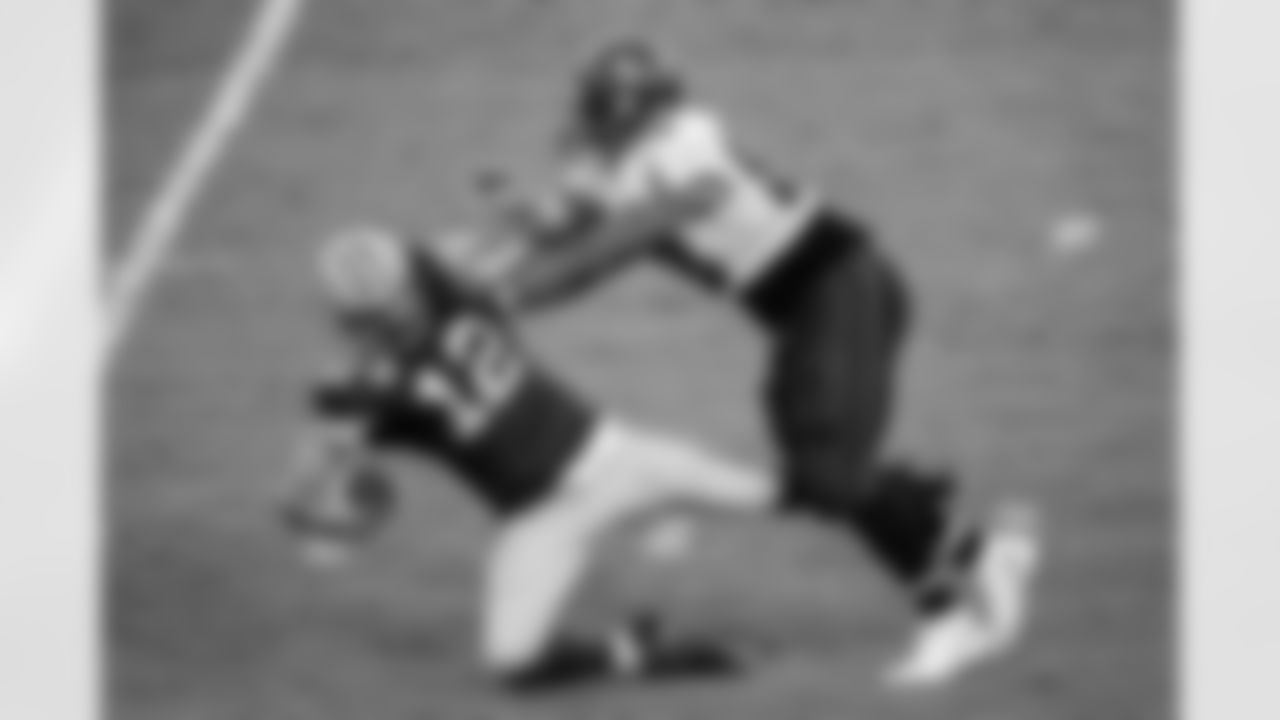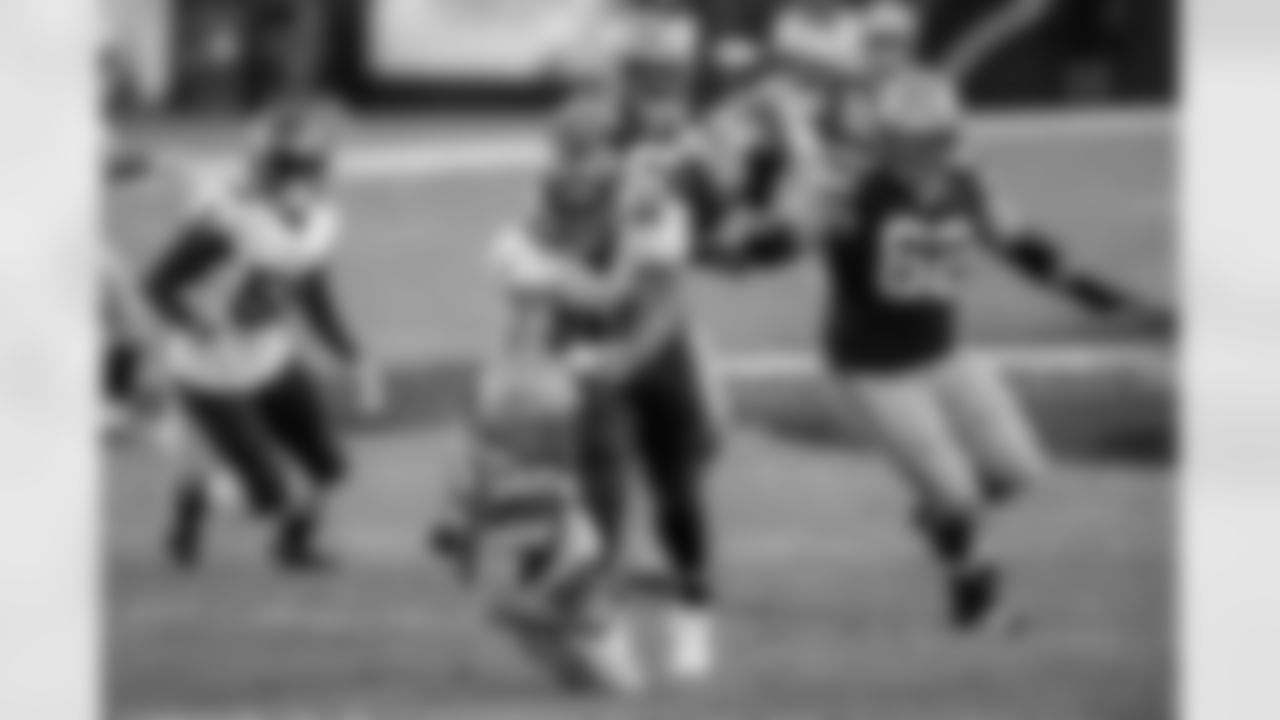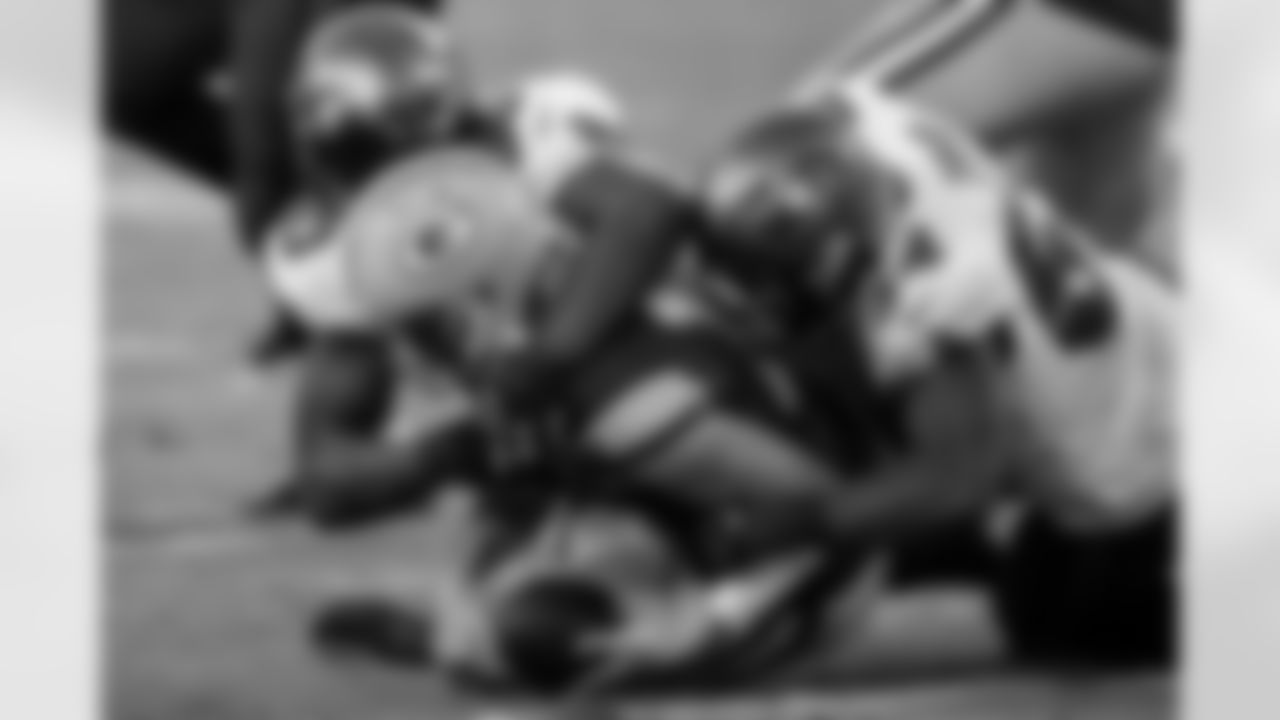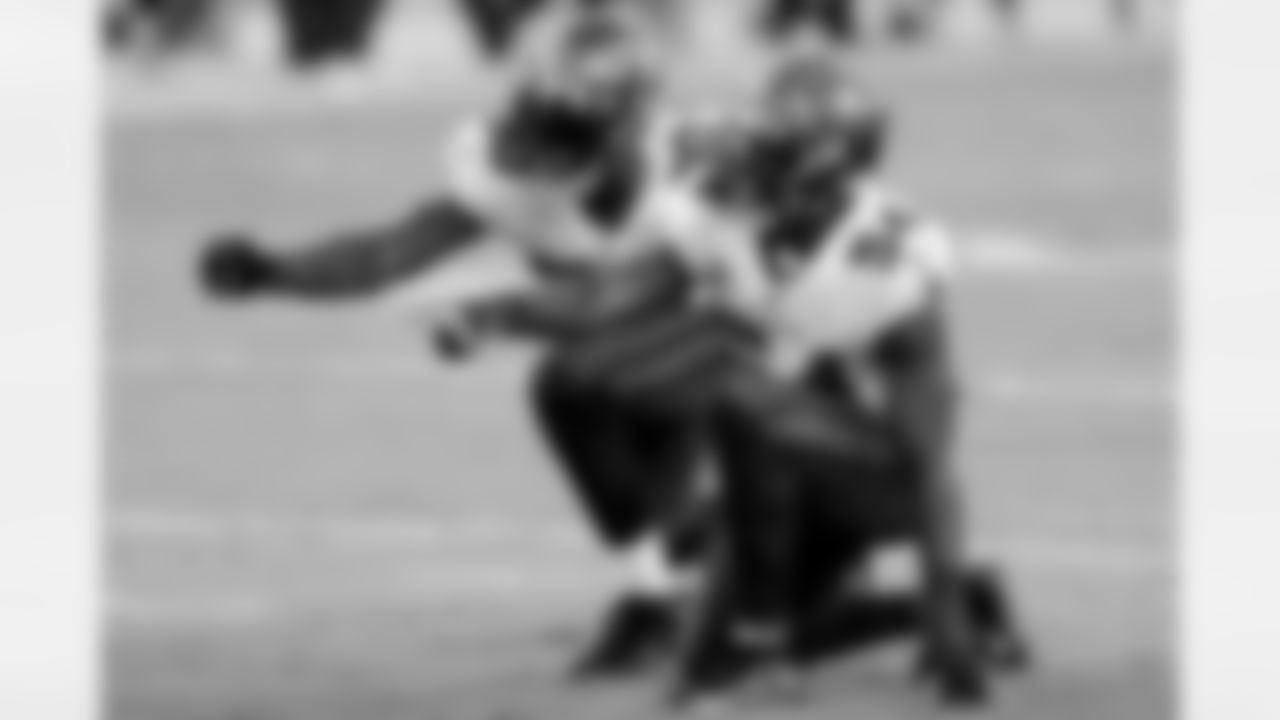Here's a stat I still find amazing, even though I personally witnessed part of it taking place: In 1997, Detroit Lions running back Barry Sanders ran for more than 100 yards in each of the last 14 games of the season.
That's not something you're going to see in the NFL every day, or every century. The longest streak of 100-yard rushing games in the last 10 years is eight, by the Cowboys' DeMarco Murray in 2014 and the Vikings' Adrian Peterson in 2012. The longest such streak by a Buccaneer is six by James Wilder, though he did that over the course of two seasons (1984-85). The longest Buc streak within one season was four, by Wilder in that same stretch, over the first four games of 1985.
Before this season, two other Buccaneers had streaks of three 100-yard rushing games – Cadillac Williams to open the 2005 season and Doug Martin in the middle of 2015. Now Ronald Jones has joined their ranks, as he's topped 100 in each of his last three games. He is the only running back in the NFL to have a streak of at least three so far this season.
When Wilder started out hot in 1985 he ended up gaining 1,400 rushing yards by season's end. Williams was a rookie in '05 and he got to 1,178 yards despite missing two games due to injury. Martin's streak in 2015 was part of a bounce-back 1,402-yard campaign. All of which is to say that Jones is probably on his way to his first 1,000-yard rushing season, given good health the rest of the way.
Very simple math will tell you that Sanders eclipsed 1,000 yards in 1997. (His streak ended, if one includes the postseason, in Tampa when he was held to 65 rushing yards in a 20-10 Buccaneers Wild Card win.) Murray and Peterson made it too, of course; in fact Peterson more than doubled it and Murray almost got to 2,000 as well.
But even much shorter streaks bode well for that back getting to quadruple digits. As noted, Jones is the only one with a streak of three or more so far this year. But over the previous 10 seasons it was accomplished 43 times within one season, most of them much shorter than 14 or eight games. In fact, 29 of them stopped at three games. Thirty-seven of those 43 streaks became part of a 1,000-yard campaign. Five of the other six probably would have if they had not been shortened by injuries; of those five, four finished with at least 934 yards and missed at least three games. The other one topped out at 853 when Frank Gore missed five games in 2010.
The only real anomaly on the list is Washington's Roy Helu in 2011. Helu played in 15 games and finished with 640 rushing yards, of which 334 came in a three-game late-season stretch when he got a chance to start. Helu would never top 300 yards in a season again and finished with 1,171 in his career.
Of course, it's just as easy to say that Jones has 472 rushing yards through six games, and based on that alone he has a good shot at 1,000, given good health. But maybe a streak like the one he's on now speaks to a level of sustained excellence he hadn't achieved before, as well as the size of his role in the Buccaneers' backfield. Whatever it all means, let's just hope the streak continues. He need 11 more to catch Barry Sanders.
View the top photos of Tampa Bay's Week 6 matchup against Green Bay.

TAMPA, FL - OCTOBER 18, 2020 - Outside Linebacker Shaquil Barrett #58 of the Tampa Bay Buccaneers before the game between the Green Bay Packers and Tampa Bay Buccaneers at Raymond James Stadium. The Buccaneers won the game, 38-10. Photo By Kyle Zedaker/Tampa Bay Buccaneers



TAMPA, FL - OCTOBER 18, 2020 - Wide Receiver Mike Evans #13 of the Tampa Bay Buccaneers with Marco Solis' family before the game between the Green Bay Packers and Tampa Bay Buccaneers at Raymond James Stadium. The Buccaneers won the game, 38-10. Photo By Kyle Zedaker/Tampa Bay Buccaneers

TAMPA, FL - OCTOBER 18, 2020 - Wide Receiver Chris Godwin #14 of the Tampa Bay Buccaneers before the game between the Green Bay Packers and Tampa Bay Buccaneers at Raymond James Stadium. The Buccaneers won the game, 38-10. Photo By Kyle Zedaker/Tampa Bay Buccaneers



TAMPA, FL - OCTOBER 18, 2020 - Inside Linebacker Devin White #45 of the Tampa Bay Buccaneers before the game between the Green Bay Packers and Tampa Bay Buccaneers at Raymond James Stadium. The Buccaneers won the game, 38-10. Photo By Kyle Zedaker/Tampa Bay Buccaneers

TAMPA, FL - OCTOBER 18, 2020 - Inside Linebacker Devin White #45, Cornerback Sean Murphy-Bunting #23, and Safety Mike Edwards #32 of the Tampa Bay Buccaneers before the game between the Green Bay Packers and Tampa Bay Buccaneers at Raymond James Stadium. The Buccaneers won the game, 38-10. Photo By Kyle Zedaker/Tampa Bay Buccaneers


TAMPA, FL - OCTOBER 18, 2020 - Center Ryan Jensen #66 and Quarterback Tom Brady #12 of the Tampa Bay Buccaneers before the game between the Green Bay Packers and Tampa Bay Buccaneers at Raymond James Stadium. The Buccaneers won the game, 38-10. Photo By Kyle Zedaker/Tampa Bay Buccaneers

TAMPA, FL - OCTOBER 18, 2020 - Quarterback Tom Brady #12 of the Tampa Bay Buccaneers before the game between the Green Bay Packers and Tampa Bay Buccaneers at Raymond James Stadium. The Buccaneers won the game, 38-10. Photo By Tori Richman/Tampa Bay Buccaneers

TAMPA, FL - OCTOBER 18, 2020 - Quarterback Tom Brady #12 of the Tampa Bay Buccaneers before the game between the Green Bay Packers and Tampa Bay Buccaneers at Raymond James Stadium. The Buccaneers won the game, 38-10. Photo By Tori Richman/Tampa Bay Buccaneers

TAMPA, FL - OCTOBER 18, 2020 - Wide Receiver Cyril Grayson #15 of the Tampa Bay Buccaneers before the game between the Green Bay Packers and Tampa Bay Buccaneers at Raymond James Stadium. The Buccaneers won the game, 38-10. Photo By Kyle Zedaker/Tampa Bay Buccaneers

TAMPA, FL - OCTOBER 18, 2020 - Wide Receiver Jaydon Mickens #85 of the Tampa Bay Buccaneers before the game between the Green Bay Packers and Tampa Bay Buccaneers at Raymond James Stadium. The Buccaneers won the game, 38-10. Photo By Tori Richman/Tampa Bay Buccaneers

TAMPA, FL - OCTOBER 18, 2020 - Wide Receiver Chris Godwin #14 and Wide Receiver Mike Evans #13 of the Tampa Bay Buccaneers before the game between the Green Bay Packers and Tampa Bay Buccaneers at Raymond James Stadium. The Buccaneers won the game, 38-10. Photo By Kyle Zedaker/Tampa Bay Buccaneers

TAMPA, FL - OCTOBER 18, 2020 - Outside Linebacker Jason Pierre-Paul #90 of the Tampa Bay Buccaneers before the game between the Green Bay Packers and Tampa Bay Buccaneers at Raymond James Stadium. The Buccaneers won the game, 38-10. Photo By Kyle Zedaker/Tampa Bay Buccaneers

TAMPA, FL - OCTOBER 18, 2020 - Quarterback Tom Brady #12 of the Tampa Bay Buccaneers before the game between the Green Bay Packers and Tampa Bay Buccaneers at Raymond James Stadium. The Buccaneers won the game, 38-10. Photo By Tori Richman/Tampa Bay Buccaneers

TAMPA, FL - OCTOBER 18, 2020 - Inside Linebacker Devin White #45 of the Tampa Bay Buccaneers before the game between the Green Bay Packers and Tampa Bay Buccaneers at Raymond James Stadium. The Buccaneers won the game, 38-10. Photo By Kyle Zedaker/Tampa Bay Buccaneers


TAMPA, FL - OCTOBER 18, 2020 - Center Ryan Jensen #66 of the Tampa Bay Buccaneers before the game between the Green Bay Packers and Tampa Bay Buccaneers at Raymond James Stadium. The Buccaneers won the game, 38-10. Photo By Kyle Zedaker/Tampa Bay Buccaneers



TAMPA, FL - OCTOBER 18, 2020 - National anthem choir performs virtually before the game between the Green Bay Packers and Tampa Bay Buccaneers at Raymond James Stadium. The Buccaneers won the game, 38-10. Photo By Jason Parkhurst/Tampa Bay Buccaneers

TAMPA, FL - OCTOBER 18, 2020 - Wide Receiver Cyril Grayson #15 of the Tampa Bay Buccaneers before the game between the Green Bay Packers and Tampa Bay Buccaneers at Raymond James Stadium. The Buccaneers won the game, 38-10. Photo By Kyle Zedaker/Tampa Bay Buccaneers


TAMPA, FL - OCTOBER 18, 2020 - Inside Linebacker Lavonte David #54 of the Tampa Bay Buccaneers before the game between the Green Bay Packers and Tampa Bay Buccaneers at Raymond James Stadium. The Buccaneers won the game, 38-10. Photo By Kyle Zedaker/Tampa Bay Buccaneers

TAMPA, FL - OCTOBER 18, 2020 - Inside Linebacker Devin White #45 of the Tampa Bay Buccaneers during the game between the Green Bay Packers and Tampa Bay Buccaneers at Raymond James Stadium. The Buccaneers won the game, 38-10. Photo By Kyle Zedaker/Tampa Bay Buccaneers

TAMPA, FL - OCTOBER 18, 2020 - Safety Antoine Winfield Jr. #31 of the Tampa Bay Buccaneers during the game between the Green Bay Packers and Tampa Bay Buccaneers at Raymond James Stadium. The Buccaneers won the game, 38-10. Photo By Kyle Zedaker/Tampa Bay Buccaneers

TAMPA, FL - OCTOBER 18, 2020 - Quarterback Tom Brady #12 of the Tampa Bay Buccaneers during the game between the Green Bay Packers and Tampa Bay Buccaneers at Raymond James Stadium. The Buccaneers won the game, 38-10. Photo By Kyle Zedaker/Tampa Bay Buccaneers

TAMPA, FL - OCTOBER 18, 2020 - Running Back Ronald Jones II #27 of the Tampa Bay Buccaneers during the game between the Green Bay Packers and Tampa Bay Buccaneers at Raymond James Stadium. The Buccaneers won the game, 38-10. Photo By Kyle Zedaker/Tampa Bay Buccaneers

TAMPA, FL - OCTOBER 18, 2020 - Wide Receiver Mike Evans #13 of the Tampa Bay Buccaneers during the game between the Green Bay Packers and Tampa Bay Buccaneers at Raymond James Stadium. The Buccaneers won the game, 38-10. Photo By Kyle Zedaker/Tampa Bay Buccaneers

TAMPA, FL - OCTOBER 18, 2020 - Outside Linebacker Shaquil Barrett #58 of the Tampa Bay Buccaneers during the game between the Green Bay Packers and Tampa Bay Buccaneers at Raymond James Stadium. The Buccaneers won the game, 38-10. Photo By Kyle Zedaker/Tampa Bay Buccaneers

TAMPA, FL - OCTOBER 18, 2020 - Safety Antoine Winfield Jr. #31 of the Tampa Bay Buccaneers during the game between the Green Bay Packers and Tampa Bay Buccaneers at Raymond James Stadium. The Buccaneers won the game, 38-10. Photo By Tori Richman/Tampa Bay Buccaneers

TAMPA, FL - OCTOBER 18, 2020 - Outside Linebacker Shaquil Barrett #58 of the Tampa Bay Buccaneers during the game between the Green Bay Packers and Tampa Bay Buccaneers at Raymond James Stadium. The Buccaneers won the game, 38-10. Photo By Kyle Zedaker/Tampa Bay Buccaneers

TAMPA, FL - OCTOBER 18, 2020 - Quarterback Tom Brady #12 of the Tampa Bay Buccaneers during the game between the Green Bay Packers and Tampa Bay Buccaneers at Raymond James Stadium. The Buccaneers won the game, 38-10. Photo By Kyle Zedaker/Tampa Bay Buccaneers

TAMPA, FL - OCTOBER 18, 2020 - Cornerback Sean Murphy-Bunting #23 of the Tampa Bay Buccaneers during the game between the Green Bay Packers and Tampa Bay Buccaneers at Raymond James Stadium. The Buccaneers won the game, 38-10. Photo By Kyle Zedaker/Tampa Bay Buccaneers

TAMPA, FL - OCTOBER 18, 2020 - Outside Linebacker Jason Pierre-Paul #90 of the Tampa Bay Buccaneers during the game between the Green Bay Packers and Tampa Bay Buccaneers at Raymond James Stadium. The Buccaneers won the game, 38-10. Photo By Matt May/Tampa Bay Buccaneers

TAMPA, FL - OCTOBER 18, 2020 - Cornerback Jamel Dean #35 of the Tampa Bay Buccaneers intercepts a pass during the game between the Green Bay Packers and Tampa Bay Buccaneers at Raymond James Stadium. The Buccaneers won the game, 38-10. Photo By Matt May/Tampa Bay Buccaneers

TAMPA, FL - OCTOBER 18, 2020 - Cornerback Jamel Dean #35 of the Tampa Bay Buccaneers intercepts a pass during the game between the Green Bay Packers and Tampa Bay Buccaneers at Raymond James Stadium. The Buccaneers won the game, 38-10. Photo By Matt May/Tampa Bay Buccaneers

TAMPA, FL - OCTOBER 18, 2020 - Cornerback Jamel Dean #35 of the Tampa Bay Buccaneers returns an interception for at touchdown during the game between the Green Bay Packers and Tampa Bay Buccaneers at Raymond James Stadium. The Buccaneers won the game, 38-10. Photo By Kyle Zedaker/Tampa Bay Buccaneers

TAMPA, FL - OCTOBER 18, 2020 - Outside Linebacker Shaquil Barrett #58, Safety Jordan Whitehead #33, Safety Mike Edwards #32, Cornerback Sean Murphy-Bunting #23, Cornerback Jamel Dean #35, Inside Linebacker Devin White #45, Safety Antoine Winfield Jr. #31, and Cornerback Carlton Davis #24 of the Tampa Bay Buccaneers celebrate an interception returned for a touchdown during the game between the Green Bay Packers and Tampa Bay Buccaneers at Raymond James Stadium. The Buccaneers won the game, 38-10. Photo By Kyle Zedaker/Tampa Bay Buccaneers

TAMPA, FL - OCTOBER 18, 2020 - Inside Linebacker Lavonte David #54 of the Tampa Bay Buccaneers during the game between the Green Bay Packers and Tampa Bay Buccaneers at Raymond James Stadium. The Buccaneers won the game, 38-10. Photo By Kyle Zedaker/Tampa Bay Buccaneers

TAMPA, FL - OCTOBER 18, 2020 - Defensive Tackle Rakeem Nunez-Roches #56, Inside Linebacker Lavonte David #54, and Defensive Lineman William Gholston #92 of the Tampa Bay Buccaneers during the game between the Green Bay Packers and Tampa Bay Buccaneers at Raymond James Stadium. The Buccaneers won the game, 38-10. Photo By Matt May/Tampa Bay Buccaneers

TAMPA, FL - OCTOBER 18, 2020 - Inside Linebacker Devin White #45 of the Tampa Bay Buccaneers during the game between the Green Bay Packers and Tampa Bay Buccaneers at Raymond James Stadium. The Buccaneers won the game, 38-10. Photo By Kyle Zedaker/Tampa Bay Buccaneers

TAMPA, FL - OCTOBER 18, 2020 - Safety Mike Edwards #32 of the Tampa Bay Buccaneers intercepts a pass during the game between the Green Bay Packers and Tampa Bay Buccaneers at Raymond James Stadium. The Buccaneers won the game, 38-10. Photo By Matt May/Tampa Bay Buccaneers

TAMPA, FL - OCTOBER 18, 2020 - Safety Mike Edwards #32 of the Tampa Bay Buccaneers celebrates after an interception during the game between the Green Bay Packers and Tampa Bay Buccaneers at Raymond James Stadium. The Buccaneers won the game, 38-10. Photo By Kyle Zedaker/Tampa Bay Buccaneers

TAMPA, FL - OCTOBER 18, 2020 - Safety Mike Edwards #32 of the Tampa Bay Buccaneers celebrates after an interception during the game between the Green Bay Packers and Tampa Bay Buccaneers at Raymond James Stadium. The Buccaneers won the game, 38-10. Photo By Kyle Zedaker/Tampa Bay Buccaneers

TAMPA, FL - OCTOBER 18, 2020 - Safety Mike Edwards #32, Inside Linebacker Devin White #45, and Outside Linebacker Jason Pierre-Paul #90 of the Tampa Bay Buccaneers celebrate a turnover during the game between the Green Bay Packers and Tampa Bay Buccaneers at Raymond James Stadium. The Buccaneers won the game, 38-10. Photo By Matt May/Tampa Bay Buccaneers

TAMPA, FL - OCTOBER 18, 2020 - Safety Mike Edwards #32 of the Tampa Bay Buccaneers celebrates an interception with Safety Jordan Whitehead #33, Inside Linebacker Devin White #45, Cornerback Sean Murphy-Bunting #23, and Outside Linebacker Shaquil Barrett #58 of the Tampa Bay Buccaneers during the game between the Green Bay Packers and Tampa Bay Buccaneers at Raymond James Stadium. The Buccaneers won the game, 38-10. Photo By Kyle Zedaker/Tampa Bay Buccaneers

TAMPA, FL - OCTOBER 18, 2020 - Running Back Ronald Jones II #27 of the Tampa Bay Buccaneers scores a touchdown during the game between the Green Bay Packers and Tampa Bay Buccaneers at Raymond James Stadium. The Buccaneers won the game, 38-10. Photo By Kyle Zedaker/Tampa Bay Buccaneers

TAMPA, FL - OCTOBER 18, 2020 - Inside Linebacker Lavonte David #54 of the Tampa Bay Buccaneers during the game between the Green Bay Packers and Tampa Bay Buccaneers at Raymond James Stadium. The Buccaneers won the game, 38-10. Photo By Kyle Zedaker/Tampa Bay Buccaneers

TAMPA, FL - OCTOBER 18, 2020 - Wide Receiver Tyler Johnson #18 of the Tampa Bay Buccaneers celebrates a touchdown during the game between the Green Bay Packers and Tampa Bay Buccaneers at Raymond James Stadium. The Buccaneers won the game, 38-10. Photo By Jason Parkhurst/Tampa Bay Buccaneers

TAMPA, FL - OCTOBER 18, 2020 - Wide Receiver Tyler Johnson #18 and Quarterback Tom Brady #12 of the Tampa Bay Buccaneers during the game between the Green Bay Packers and Tampa Bay Buccaneers at Raymond James Stadium. The Buccaneers won the game, 38-10. Photo By Tori Richman/Tampa Bay Buccaneers

TAMPA, FL - OCTOBER 18, 2020 - Wide Receiver Tyler Johnson #18 celebrates a touchdown with Running Back Ke'Shawn Vaughn #30 and Wide Receiver Jaydon Mickens #85 of the Tampa Bay Buccaneers during the game between the Green Bay Packers and Tampa Bay Buccaneers at Raymond James Stadium. The Buccaneers won the game, 38-10. Photo By Jason Parkhurst/Tampa Bay Buccaneers

TAMPA, FL - OCTOBER 18, 2020 - Inside Linebacker Lavonte David #54 of the Tampa Bay Buccaneers celebrates a sack during the game between the Green Bay Packers and Tampa Bay Buccaneers at Raymond James Stadium. The Buccaneers won the game, 38-10. Photo By Kyle Zedaker/Tampa Bay Buccaneers

TAMPA, FL - OCTOBER 18, 2020 - Inside Linebacker Lavonte David #54 and Inside Linebacker Devin White #45 of the Tampa Bay Buccaneers celebrate a sack during the game between the Green Bay Packers and Tampa Bay Buccaneers at Raymond James Stadium. The Buccaneers won the game, 38-10. Photo By Matt May/Tampa Bay Buccaneers

TAMPA, FL - OCTOBER 18, 2020 - Inside Linebacker Lavonte David #54 of the Tampa Bay Buccaneers celebrates a sack with Inside Linebacker Devin White #45 during the game between the Green Bay Packers and Tampa Bay Buccaneers at Raymond James Stadium. The Buccaneers won the game, 38-10. Photo By Kyle Zedaker/Tampa Bay Buccaneers

TAMPA, FL - OCTOBER 18, 2020 - Running Back Ronald Jones II #27 of the Tampa Bay Buccaneers during the game between the Green Bay Packers and Tampa Bay Buccaneers at Raymond James Stadium. The Buccaneers won the game, 38-10. Photo By Jason Parkhurst/Tampa Bay Buccaneers

TAMPA, FL - OCTOBER 18, 2020 - Wide Receiver Chris Godwin #14 of the Tampa Bay Buccaneers during the game between the Green Bay Packers and Tampa Bay Buccaneers at Raymond James Stadium. The Buccaneers won the game, 38-10. Photo By Matt May/Tampa Bay Buccaneers

TAMPA, FL - OCTOBER 18, 2020 - Tight End Rob Gronkowski #87 of the Tampa Bay Buccaneers during the game between the Green Bay Packers and Tampa Bay Buccaneers at Raymond James Stadium. The Buccaneers won the game, 38-10. Photo By Tori Richman/Tampa Bay Buccaneers

TAMPA, FL - OCTOBER 18, 2020 - Tight End Rob Gronkowski #87 of the Tampa Bay Buccaneers during the game between the Green Bay Packers and Tampa Bay Buccaneers at Raymond James Stadium. The Buccaneers won the game, 38-10. Photo By Tori Richman/Tampa Bay Buccaneers

TAMPA, FL - OCTOBER 18, 2020 - Quarterback Tom Brady #12 celebrates a touchdown with Tight End Rob Gronkowski #87 of the Tampa Bay Buccaneers during the game between the Green Bay Packers and Tampa Bay Buccaneers at Raymond James Stadium. The Buccaneers won the game, 38-10. Photo By Kyle Zedaker/Tampa Bay Buccaneers

TAMPA, FL - OCTOBER 18, 2020 - Inside Linebacker Devin White #45 of the Tampa Bay Buccaneers during the game between the Green Bay Packers and Tampa Bay Buccaneers at Raymond James Stadium. The Buccaneers won the game, 38-10. Photo By Kyle Zedaker/Tampa Bay Buccaneers

TAMPA, FL - OCTOBER 18, 2020 - Defensive Tackle Ndamukong Suh #93 of the Tampa Bay Buccaneers during the game between the Green Bay Packers and Tampa Bay Buccaneers at Raymond James Stadium. The Buccaneers won the game, 38-10. Photo By Tori Richman/Tampa Bay Buccaneers

TAMPA, FL - OCTOBER 18, 2020 - Defensive Tackle Ndamukong Suh #93 of the Tampa Bay Buccaneers during the game between the Green Bay Packers and Tampa Bay Buccaneers at Raymond James Stadium. The Buccaneers won the game, 38-10. Photo By Jason Parkhurst/Tampa Bay Buccaneers

TAMPA, FL - OCTOBER 18, 2020 - Defensive Tackle Ndamukong Suh #93 of the Tampa Bay Buccaneers during the game between the Green Bay Packers and Tampa Bay Buccaneers at Raymond James Stadium. The Buccaneers won the game, 38-10. Photo By Matt May/Tampa Bay Buccaneers

TAMPA, FL - OCTOBER 18, 2020 - Defensive Tackle Ndamukong Suh #93 of the Tampa Bay Buccaneers during the game between the Green Bay Packers and Tampa Bay Buccaneers at Raymond James Stadium. The Buccaneers won the game, 38-10. Photo By Kyle Zedaker/Tampa Bay Buccaneers

TAMPA, FL - OCTOBER 18, 2020 - Defensive Tackle Ndamukong Suh #93 and Defensive Lineman Jeremiah Ledbetter #95 of the Tampa Bay Buccaneers celebrate a sack during the game between the Green Bay Packers and Tampa Bay Buccaneers at Raymond James Stadium. The Buccaneers won the game, 38-10. Photo By Kyle Zedaker/Tampa Bay Buccaneers

TAMPA, FL - OCTOBER 18, 2020 - Defensive Tackle Ndamukong Suh #93 of the Tampa Bay Buccaneers during the game between the Green Bay Packers and Tampa Bay Buccaneers at Raymond James Stadium. The Buccaneers won the game, 38-10. Photo By Tori Richman/Tampa Bay Buccaneers

TAMPA, FL - OCTOBER 18, 2020 - Quarterback Tom Brady #12 of the Tampa Bay Buccaneers during the game between the Green Bay Packers and Tampa Bay Buccaneers at Raymond James Stadium. The Buccaneers won the game, 38-10. Photo By Kyle Zedaker/Tampa Bay Buccaneers

TAMPA, FL - OCTOBER 18, 2020 - Kicker Ryan Succop #3 of the Tampa Bay Buccaneers during the game between the Green Bay Packers and Tampa Bay Buccaneers at Raymond James Stadium. The Buccaneers won the game, 38-10. Photo By Matt May/Tampa Bay Buccaneers

TAMPA, FL - OCTOBER 18, 2020 - Kicker Ryan Succop #3 of the Tampa Bay Buccaneers celebrates a field goal made with teammates during the game between the Green Bay Packers and Tampa Bay Buccaneers at Raymond James Stadium. The Buccaneers won the game, 38-10. Photo By Kyle Zedaker/Tampa Bay Buccaneers

TAMPA, FL - OCTOBER 18, 2020 - Kicker Ryan Succop #3 of the Tampa Bay Buccaneers celebrates a made field goal during the game between the Green Bay Packers and Tampa Bay Buccaneers at Raymond James Stadium. The Buccaneers won the game, 38-10. Photo By Mike Carlson/Tampa Bay Buccaneers

TAMPA, FL - OCTOBER 18, 2020 - Outside Linebacker Jason Pierre-Paul #90 and Inside Linebacker Lavonte David #54 of the Tampa Bay Buccaneers during the game between the Green Bay Packers and Tampa Bay Buccaneers at Raymond James Stadium. The Buccaneers won the game, 38-10. Photo By Tori Richman/Tampa Bay Buccaneers

TAMPA, FL - OCTOBER 18, 2020 - Inside Linebacker Devin White #45 of the Tampa Bay Buccaneers during the game between the Green Bay Packers and Tampa Bay Buccaneers at Raymond James Stadium. The Buccaneers won the game, 38-10. Photo By Tori Richman/Tampa Bay Buccaneers

TAMPA, FL - OCTOBER 18, 2020 - Outside Linebacker Jason Pierre-Paul #90 of the Tampa Bay Buccaneers celebrates a sack with Inside Linebacker Lavonte David #54 of the Tampa Bay Buccaneers during the game between the Green Bay Packers and Tampa Bay Buccaneers at Raymond James Stadium. The Buccaneers won the game, 38-10. Photo By Kyle Zedaker/Tampa Bay Buccaneers

TAMPA, FL - OCTOBER 18, 2020 - Inside Linebacker Lavonte David #54 and Outside Linebacker Jason Pierre-Paul #90 of the Tampa Bay Buccaneers during the game between the Green Bay Packers and Tampa Bay Buccaneers at Raymond James Stadium. The Buccaneers won the game, 38-10. Photo By Mike Carlson/Tampa Bay Buccaneers

TAMPA, FL - OCTOBER 18, 2020 - Outside Linebacker Jason Pierre-Paul #90 and Inside Linebacker Lavonte David #54 of the Tampa Bay Buccaneers celebrate a sack during the game between the Green Bay Packers and Tampa Bay Buccaneers at Raymond James Stadium. The Buccaneers won the game, 38-10. Photo By Matt May/Tampa Bay Buccaneers

TAMPA, FL - OCTOBER 18, 2020 - Outside Linebacker Jason Pierre-Paul #90 of the Tampa Bay Buccaneers celebrates a sack with Inside Linebacker Lavonte David #54 of the Tampa Bay Buccaneers during the game between the Green Bay Packers and Tampa Bay Buccaneers at Raymond James Stadium. The Buccaneers won the game, 38-10. Photo By Kyle Zedaker/Tampa Bay Buccaneers

TAMPA, FL - OCTOBER 18, 2020 - Outside Linebacker Jason Pierre-Paul #90 of the Tampa Bay Buccaneers during the game between the Green Bay Packers and Tampa Bay Buccaneers at Raymond James Stadium. The Buccaneers won the game, 38-10. Photo By Mike Carlson/Tampa Bay Buccaneers

TAMPA, FL - OCTOBER 18, 2020 - Quarterback Tom Brady #12 of the Tampa Bay Buccaneers during the game between the Green Bay Packers and Tampa Bay Buccaneers at Raymond James Stadium. The Buccaneers won the game, 38-10. Photo By Jason Parkhurst/Tampa Bay Buccaneers

TAMPA, FL - OCTOBER 18, 2020 - Running Back Ronald Jones II #27 of the Tampa Bay Buccaneers scores a touchdown during the game between the Green Bay Packers and Tampa Bay Buccaneers at Raymond James Stadium. The Buccaneers won the game, 38-10. Photo By Mike Carlson/Tampa Bay Buccaneers

TAMPA, FL - OCTOBER 18, 2020 - Inside Linebacker Lavonte David #54 of the Tampa Bay Buccaneers during the game between the Green Bay Packers and Tampa Bay Buccaneers at Raymond James Stadium. The Buccaneers won the game, 38-10. Photo By Tori Richman/Tampa Bay Buccaneers

TAMPA, FL - OCTOBER 18, 2020 - Defensive Tackle Ndamukong Suh #93 of the Tampa Bay Buccaneers during the game between the Green Bay Packers and Tampa Bay Buccaneers at Raymond James Stadium. The Buccaneers won the game, 38-10. Photo By Kyle Zedaker/Tampa Bay Buccaneers

TAMPA, FL - OCTOBER 18, 2020 - Inside Linebacker Devin White #45 of the Tampa Bay Buccaneers during the game between the Green Bay Packers and Tampa Bay Buccaneers at Raymond James Stadium. The Buccaneers won the game, 38-10. Photo By Matt May/Tampa Bay Buccaneers

TAMPA, FL - OCTOBER 18, 2020 - Inside Linebacker Devin White #45 of the Tampa Bay Buccaneers celebrates a sack during the game between the Green Bay Packers and Tampa Bay Buccaneers at Raymond James Stadium. The Buccaneers won the game, 38-10. Photo By Matt May/Tampa Bay Buccaneers

TAMPA, FL - OCTOBER 18, 2020 - Outside Linebacker Jason Pierre-Paul #90 of the Tampa Bay Buccaneers during the game between the Green Bay Packers and Tampa Bay Buccaneers at Raymond James Stadium. The Buccaneers won the game, 38-10. Photo By Kyle Zedaker/Tampa Bay Buccaneers

TAMPA, FL - OCTOBER 18, 2020 - Outside Linebacker Jason Pierre-Paul #90 of the Tampa Bay Buccaneers during the game between the Green Bay Packers and Tampa Bay Buccaneers at Raymond James Stadium. The Buccaneers won the game, 38-10. Photo By Tori Richman/Tampa Bay Buccaneers

TAMPA, FL - OCTOBER 18, 2020 - Quarterback Tom Brady #12 of the Tampa Bay Buccaneers and Aaron Rodgers after the game between the Green Bay Packers and Tampa Bay Buccaneers at Raymond James Stadium. The Buccaneers won the game, 38-10. Photo By Kyle Zedaker/Tampa Bay Buccaneers

TAMPA, FL - OCTOBER 18, 2020 - Guard Ali Marpet #74 of the Tampa Bay Buccaneers gives fans a thumbs up after the game between the Green Bay Packers and Tampa Bay Buccaneers at Raymond James Stadium. The Buccaneers won the game, 38-10. Photo By Kyle Zedaker/Tampa Bay Buccaneers

TAMPA, FL - OCTOBER 18, 2020 - Head Coach Bruce Arians of the Tampa Bay Buccaneers after the game between the Green Bay Packers and Tampa Bay Buccaneers at Raymond James Stadium. The Buccaneers won the game, 38-10. Photo By Tori Richman/Tampa Bay Buccaneers

TAMPA, FL - OCTOBER 18, 2020 - Offensive Tackle Donovan Smith #76 of the Tampa Bay Buccaneers after the game between the Green Bay Packers and Tampa Bay Buccaneers at Raymond James Stadium. The Buccaneers won the game, 38-10. Photo By Kyle Zedaker/Tampa Bay Buccaneers

TAMPA, FL - OCTOBER 18, 2020 - Wide Receiver Tyler Johnson #18 of the Tampa Bay Buccaneers after the game between the Green Bay Packers and Tampa Bay Buccaneers at Raymond James Stadium. The Buccaneers won the game, 38-10. Photo By Kyle Zedaker/Tampa Bay Buccaneers

TAMPA, FL - OCTOBER 18, 2020 - Wide Receiver Tyler Johnson #18 of the Tampa Bay Buccaneers after the game between the Green Bay Packers and Tampa Bay Buccaneers at Raymond James Stadium. The Buccaneers won the game, 38-10. Photo By Kyle Zedaker/Tampa Bay Buccaneers

TAMPA, FL - OCTOBER 18, 2020 - Safety Antoine Winfield Jr. #31 of the Tampa Bay Buccaneers after the game between the Green Bay Packers and Tampa Bay Buccaneers at Raymond James Stadium. The Buccaneers won the game, 38-10. Photo By Tori Richman/Tampa Bay Buccaneers

TAMPA, FL - OCTOBER 18, 2020 - Cornerback Jamel Dean #35 of the Tampa Bay Buccaneers after the game between the Green Bay Packers and Tampa Bay Buccaneers at Raymond James Stadium. The Buccaneers won the game, 38-10. Photo By Kyle Zedaker/Tampa Bay Buccaneers

TAMPA, FL - OCTOBER 18, 2020 - Tackle Tristan Wirfs #78 of the Tampa Bay Buccaneers after the game between the Green Bay Packers and Tampa Bay Buccaneers at Raymond James Stadium. The Buccaneers won the game, 38-10. Photo By Kyle Zedaker/Tampa Bay Buccaneers

TAMPA, FL - OCTOBER 18, 2020 - Tackle Tristan Wirfs #78 of the Tampa Bay Buccaneers after the game between the Green Bay Packers and Tampa Bay Buccaneers at Raymond James Stadium. The Buccaneers won the game, 38-10. Photo By Tori Richman/Tampa Bay Buccaneers
Now on to your questions for this week.
A reminder that you can send questions to me anytime you want on Twitter (@ScottSBucs) and they're easier to find if you include the hashtag #SSMailbagBucs. We are also now soliciting questions each week on our Instagram page; look for that story on Wednesdays. As always, if you want to get a longer question into the mailbag and would prefer to email your question, you can do so to tbbsocial@buccaneers.nfl.com.
Why aren't we utilizing Evans more? Should we be concerned with his low-yard games?
- @50hhh_silva (via Instagram)
I've started a couple of answers this season with a version of this same thing: There's a difference between how much a player is being "utilized" and how many stats he is piling up.
Mike Evans has been on the field for 84% of the Buccaneers' offensive snaps this season. That's much higher than last year, when he only got in for 70% of the snaps, but of course that was largely because he missed the last three games of the season with a hamstring injury. However, Evans played in all 16 games in 2018 and was on the field for…84% of the Bucs' offensive snaps. In fact, Evans' usage rate so far this season equals 2018 for the highest in his career.
So we've established that Mike is being utilized on offense. Now, the only way to know that he was the first read on any given pass play would be to go through each game, play by play, with Bruce Arians or Byron Leftwich and ask them. That's not really an option, so if by "utilize" you mean, attempt to get him the football, I'm not going to be able to give you a solid answer. However, given how good we all know Evans is, it's pretty logical to believe that the Buccaneers go into every game with the intention of throwing it to him on multiple occasions.
But, as Arians has said countless times, the defense often dictates where the football goes. Opposing teams sometimes choose to design their coverage to make it as hard as possible to get the ball to Evans. That can mean giving him bracket coverage with two defenders most of the game or deploying a "shutdown corner" – for those teams lucky enough to have one – to follow him around the entire game. That first approach was definitely what Denver went with in Week Three and Evans' only two catches were one-yard touchdowns. Meanwhile, Rob Gronkowski, Chris Godwin, Scotty Miller and O.J. Howard combined for 22 targets, 17 catches and 244 yards. The Broncos blanketed Evans at the expense of other areas on the field and Brady threw to the open man. That's his job.
Evans does lead the team with 37 targets, though the numbers show that the ball has been spread around quite a bit. Gronkowski has 28, Miller 23, Ronald Jones 25, Godwin 20 despite missing three games and Howard 19 despite hitting I.R. after Week Four. Evans also has two 100-yard games this season and he is second in the NFL with six touchdown catches. You definitely can't quibble with how Evans has been used around the goal line.
Chris Godwin is back, and even though Evans only had one catch in Week Six while Godwin had five, I think this is probably a good thing for Evans' numbers going forward. When Evans and Godwin are both in the game and healthy (something that hasn't happed much yet this year), opposing defenses probably look at them as the Bucs' 1A and 1B receivers. Godwin's presence may lead to fewer team's focusing their coverage heavily on Evans.
Remember, too, that Evans has been playing through a pretty tough ankle injury for the last two-and-a-half games. And he was slowed by a balky hamstring in the season opener. I don't think we've seen peak Mike Evans just yet; assuming he continues to feel better and better and doesn't incur another injury, I would expect his numbers to go up in the months ahead.
Can the Bucs continue to have low penalty games? What do you think contributed to the limited mistakes Sunday?
- @bsreddy95 (via Instagram)
I think they can have more low-penalty games, but I don't want to be blindly optimistic. The cynic would surely point out that in the 21 previous games since the start of the 2019 season, the Buccaneers had committed eight or more accepted penalties in 14 of them. This was just the third time in 22 games that the Bucs had been flagged five or fewer teams.
I know you're not asking if the Buccaneers will have more zero-penalty games. That would be absurd, given that Sunday's win over Green Bay marked just the second time in 45 seasons that the Bucs have gone a whole game without an accepted penalty against them. But getting down to about five penalties per contest would be a reasonable goal; there are currently 10 NFL teams averaging 5.0 or fewer accepted flags per game. After the Bucs' clean game against the Packers they lowered their average from 8.4 per game to 7.0. Getting there.
I do think the Buccaneers can have more low-penalty games as the season goes on and they continue to make it a daily point of emphasis during the week of practice. Remember that the Bucs had no preseason games to warm up with this year, and that's especially tough on rookies trying to transition to the NFL. They also were not able to have officiating crews at practice during training camp, due to the pandemic, and that's something every team does on an annual basis in a more normal year.
If the Buccaneers really can become more disciplined on a weekly basis, they will be playing in an environment that should naturally help them reduce penalties. Prior to the season NFL Senior Vice President of Officiating Training and Development instructed game officials to focus on infractions that were "clear and obvious." As a result, the number of flags thrown across the league has dropped in 2020 to 5.7 per team per game. That's one penalty fewer per team per game than last year, when the average was 6.7.
As for what I think helped create such a clean game for the Bucs against Green Bay, it sounds like it had a lot to do with a couple of really good practices on Thursday and Friday. After the game, several coaches and players raved about how well those practices went and how prepared they felt to execute the game plan, especially on defense. When you're playing well and you know what you're supposed to do on every snap, you can perform more precisely and avoid making mistakes that lead to penalties.
It also helped in this particular case that the Buccaneers ran the ball 35 times and only had 28 pass drop-backs. That was by far their most lopsided distribution of plays in favor of the run this season. Through the first five games of the season the Bucs had run 204 passing plays and run it 120 times. Obviously you can draw penalties on running plays but I believe there is more opportunity for error on passing plays. You're more likely to get a holding call on a lineman on a pass, since the alternative is sometimes getting your quarterback demolished. You also can have offensive pass-interference, intentional grounding and ineligible men downfield, and a I think a linemen is more likely to false start when he's trying to get back into his pass set.
Sunday's game is certainly a reason for confidence, and I think the Buccaneers have an excellent coaching staff that can help resolve this issue. That said, if the Bucs had been a very infrequently-penalized team and then they had one game in which they got flagged a dozen times I wouldn't be trying to convince you that they were suddenly a completely undisciplined team destined to keep piling up the penalties. So let's get a few more games in with low penalties before we decide that the Bucs have fully turned the corner on this issue.
How will the new nose tackle help our defense?
- @jayyyrxbxll (via Instagram)
If you missed it because you were still basking in the glow of that dominant win over Green Bay on Sunday night, news broke that evening that the Buccaneers and Jets had agreed on a trade to send veteran nose tackle Steve McLendon to Tampa in exchange for a late-round swap of future draft picks. The deal was finalized on Tuesday and McLendon should be able to join the team later this week after he has passed through the COVID-19 protocol. There shouldn't be much concern about McLendon's health or virus status, given that he made his sixth straight start for the Jets on Sunday against Miami.
McLendon helps most obviously in that he gives the Bucs a veteran run-plugger to replace the injured Vita Vea in the rotation on the interior D-Line. Rakeem Nunez-Roches has shifted up to the starting line but prior to Vea's season-ending injury in Week Five the Bucs had fallen into essentially a two-man rotation at nose, with Vea getting around 45 snaps a game and Nunez-Roches getting about 30. It wasn't always a one-for-one replacement between Vea and Nunez-Roches, but that was the majority of it.
Nunez-Roches got a season-high 36 snaps (out of a possible 63) on Sunday but the Buccaneers also gave 24 snaps to Jeremiah Ledbetter, who had just been elevated from the practice squad to play in that game. Given that McLendon has already proved himself across 144 games and 90 starts in the NFL, the Buccaneers probably view him as a better option to split snaps with Nunez-Roches, and they were able to get him at a very low price.
The Buccaneers held Aaron Jones to 15 yards on 10 carries but did give up 94 rushing yards overall to the Packers, including the first two runs of 15 or more yards they had allowed all season. Tampa Bay still has the NFL's number-one ranked rush defense, just like they did last year, but it's reasonable to wonder if they'll be able to remain quite as stout without Vea, who was a rising star in his third NFL season.
Arians said on Tuesday that the Bucs wanted McLendon to help them "shore up against some of these big-time running teams." Those games will mostly come during a stretch in November and December when the Buccaneers will face the Rams, Chiefs and Vikings in a row. Those three teams are ranked 10th, sixth and eighth, respectively, in rushing so far this season.
The thing is McLendon might even be able to add some juice to the pass-rush, as well. McLendon didn't have a sack in his six games with the Jets this year but last season he had 2.5 sacks, seven quarterback hits and 10 QB pressures. That's not quite what Vea was contributing – he had 21 pressures last year and another five through five games this year – but it helps. And McLendon had his best sack season, with 3.5, while playing in Todd Bowles' defense in New York in 2016.
The Buccaneers probably also like what McLendon will bring to the locker room. Bowles obviously knows him well and Arians called him "really a quality human being" on Tuesday. Bowles regarded McLendon as one of the Jets' leaders while he was the team's head coach and that leadership should help a largely young defense, just like Ndamukong Suh and Lavonte David have.

































